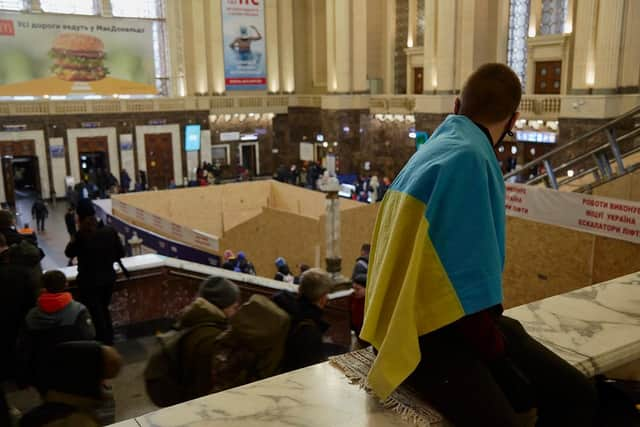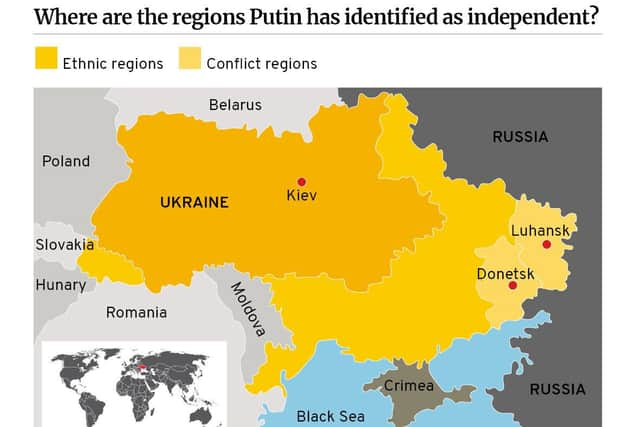Russia-Ukraine: Why is Russia invading Ukraine? When did the conflict start? Here’s everything you need to know so far
The reasons and triggers behind national tensions and geopolitical conflicts can seem daunting and complicated to the average person observing from the outside, just like with Russia’s invasion of Ukraine.
That along with strong statements from politicians and public officials, news headlines and devastating images being circulated on social media can make it even more difficult to digest.
Advertisement
Hide AdAdvertisement
Hide AdSo to give you a better understanding of the conflict between Russia and Ukraine, including how it all started, we have outlined the key points below for you.


Here is everything you need to know.
Why is there conflict between Russia and Ukraine?
While events have escalated dramatically in the last few months, tensions between Ukraine and Russia have been rising for a long time.
The current pressures have been ongoing since the 2014 overthrow of the pro-Moscow Ukrainian government.


Russia saw this development as a sign that Ukraine could more closely align itself with the West in the future.
Advertisement
Hide AdAdvertisement
Hide AdIn retaliation, Russian troops took control of Crimea, a peninsula in the south of Ukraine.
Russia then introduced a referendum in Crimea, where voters were asked whether the disputed territory should officially join the country of Russia.
Even though a large proportion of citizens (95 per cent) voted in favour of joining Russia and the Crimean Parliament quickly declaring independence from Ukraine, the referendum is not legally recognised by the international community.
Ukraine and the world community still consider Crimea to be a Ukrainian territory under law.
Advertisement
Hide AdAdvertisement
Hide AdThe war has been ongoing ever since, and the UN states that approximately 14,200 people have been killed in eastern Ukraine, including 3,000 civilians.
Why is Russia invading Ukraine?
A simplistic explanation is that Russian President Vladimir Putin believes that Ukraine is traditionally part of Russia and as such would like it back under his country’s control.
Putin decided to recognise the regions in east Ukraine, Donetsk and Luhansk, as independent states on Monday, February 21.
These areas are under the control of pro-Russian separatists supported by the Russian government.
Advertisement
Hide AdAdvertisement
Hide AdHe has since sent troops into the two regions to “maintain peace” - crossing the red line set by the West by deploying Russian forces on Ukrainian territory.
In the early morning of Thursday, February 24, Putin stated that Russia will conduct a military operation in eastern Ukraine.
He added that Russia does not have a plan to occupy Ukraine, but said that the responsibility for bloodshed lies with the Ukrainian “regime”.
Putin also warned other countries that any efforts to intervene with the Russian action would lead to “consequences they have never seen”.
Advertisement
Hide AdAdvertisement
Hide AdPutin also views Ukraine’s proposed admission to NATO as forbidden. He has accused the US and its allies of ignoring Russia’s order to ban Ukraine from joining NATO and offer Moscow security guarantees.
He said the Russian military operation aims to ensure a “demilitarisation” of Ukraine, adding that all Ukrainian troops who lay down their weapons will be able to leave the zone of combat safely.
How has the West reacted?
Putin’s actions have received a negative response from leaders all over the world, with many countries imposing sanctions on Russia as a result.
Sanctions are a diplomatic device to restrict countries without having to use combat with the aim of maintaining or restoring international peace and security. They are usually financial and can limit how easy it is for one country to trade with another, or freeze important overseas assets.
Advertisement
Hide AdAdvertisement
Hide AdThat first round of sanctions does not appear to have threatened Putin, who has invaded Ukraine, so tougher measures are likely to be put in place.
The UK Prime Minister, Boris Johnson, said: “We have Ukrainian friends in this country, neighbours, co-workers. Ukraine is a country that for decades has enjoyed freedom and democracy and the right to choose its own destiny.
“We and the world cannot allow that freedom just to be snuffed out. We cannot and will not just look away.
“It’s because we’ve been so alarmed in recent months at Russian intimidation that the UK became one of the first countries in Europe to send defensive weaponry to help the Ukrainians.
Advertisement
Hide AdAdvertisement
Hide Ad“Other allies have now done the same and we will do what more we can in the days ahead. Today, in concert with our allies we will agree to a massive package of economic sanctions designed in time to hobble the Russian economy. And to that end, we must also collectively cease the dependence on Russian oil and gas that for too long has given Putin his grip on Western politics.
“Our mission is clear. Diplomatically, politically, economically, and eventually, military, this hideous and barbaric venture of Vladimir Putin must end in failure.”
Comment Guidelines
National World encourages reader discussion on our stories. User feedback, insights and back-and-forth exchanges add a rich layer of context to reporting. Please review our Community Guidelines before commenting.